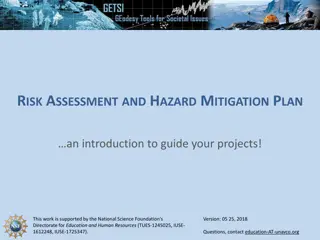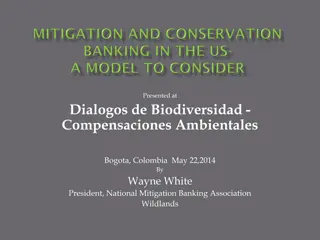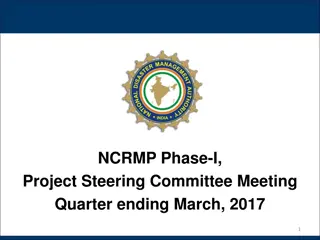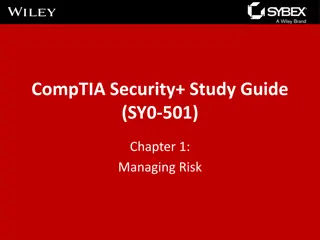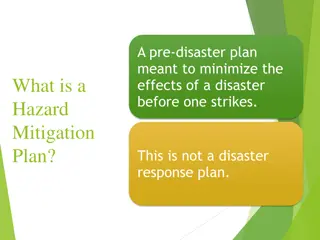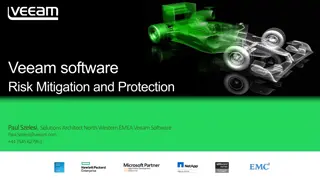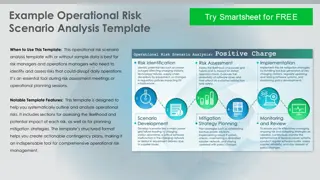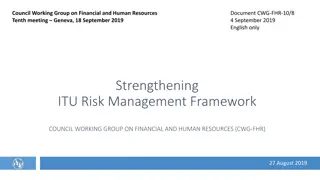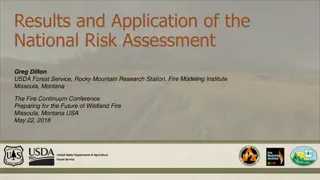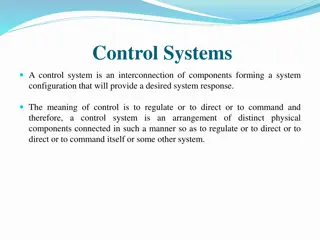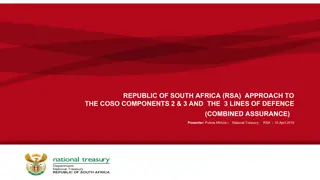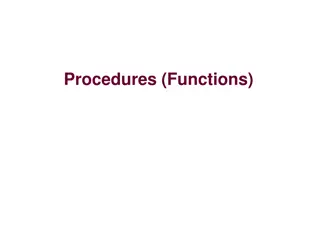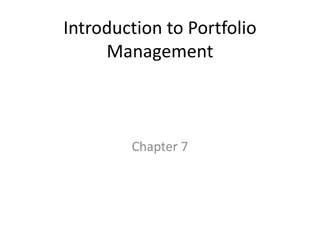Understanding Risk Mitigation Functions in Vehicle Control Systems
Risk Mitigation Functions (RMF) play a crucial role in ensuring vehicle safety by taking over control when a driver is unable to perform their driving tasks, such as in a medical emergency. This involves systems like Corrective Steering Functions (CSF) that intervene to maintain vehicle stability or prevent lane departure. Various scenarios and examples demonstrate how RMF functions work to transfer the vehicle to a safe state in emergency situations.
- Risk Mitigation Functions
- Vehicle Safety
- Corrective Steering Functions
- Driver Assistance Systems
- Lane Departure Protection
Download Presentation

Please find below an Image/Link to download the presentation.
The content on the website is provided AS IS for your information and personal use only. It may not be sold, licensed, or shared on other websites without obtaining consent from the author. Download presentation by click this link. If you encounter any issues during the download, it is possible that the publisher has removed the file from their server.
E N D
Presentation Transcript
OICA/CLEPA Input to the TF ADAS special session dedicated to RMF (ADAS 04-04) 1
What is a Risk Mitigation function? What is a Risk Mitigation Function? When the driver unexpectedly becomes unable to perform the driving task, e.g. due to a medical emergency, the system takes over lateral and longitudinal control of the vehicle aiming to transfer the vehicle to a safe state (=standstill). What indicates for example that the driver is unable to perform the driving task? The driver is not properly controlling the vehicle, e.g. consecutive CSF lane departure protection The driver is not responding to a request for action for a prolongued period of time, e.g. hands-off warning A driver monitoring system detects that the driver is unable to perform the driving task The driver (or a passenger) indicates an emergency situation, e.g. through an Emergency Stop Button Possible example scenarios for activation: 1) 3) RMF intervention + warning RMF intervention + warning CSF (lane departure correction) Intervention + warning Driver indicates Emergency Situation 2) 4) There are more examples, like a Driver Monitoring System triggering an RMF intervention. RMF intervention + warning B1 hands-off warning B1 off 2
UN-R79/01Suppl.05 UN-R79/02 and UN-R79/03 2.3.4.2. "Corrective steering function" means the discontinuous control function within a complex electronic control system whereby, for a limited duration, changes to the steering angle of one or more wheels may result from the automatic evaluation of signals initiated on-board the vehicle, in order to maintain the basic desired path of the vehicle or to influence the vehicle s dynamic behaviour. 2.3.4.2. "Corrective Steering Function (CSF)" means a control function within an electronic control system whereby, for a limited duration, changes to the steering angle of one or more wheels may result from the automatic evaluation of signals initiated on-board the vehicle, in order: (a) To compensate a sudden, unexpected change in the side force of the vehicle, or; (b) To improve the vehicle stability (e.g. side wind, differing adhesion road con- ditions " -split"), or; (c) To correct lane departure. (e.g. to avoid crossing lane markings, leaving the road). Systems that do not themselves positively actuate the steering system but that, possibly in conjunction with passive infrastructure features, simply warn the driver of a deviation from the ideal path of the vehicle, or of an unseen hazard, by means of a tactile warning transmitted through the steering control, are also considered to be corrective steering. 2.3.4.1.4."ACSF of Category C" means, a function which is initiated/activated by the driver and which can perform a single lateral manoeuvre (e.g. lane change) when commanded by the driver. 2.3.4.1.6."ACSF of Category E" means a function which is initiated/activated by the driver and which can continuously determine the possibility of a manoeuvre (e.g. lane change) and complete these manoeuvres for extended periods without further driver command/confirmation. Specific CSF requirements (Chapter 5) + Annex 6 CEL Emergency stop in lane possible (timely limited) Emergency stop with lane change possible (timely limited) Specific CSF requirements (Chapter 5) + Annex 6 CEL Emergency stop in lane possible (timely limited) Emergency stop with lane change no longer possible (timely limited)
Urgency in Timing for RMF UN-R79/03 Suppl.03 12.2. Transitional Provisions applicable to the 03 series of amendments: 12.2.1. As from the official date of entry into force of the 03 series of amendments, no Contracting Party applying this UN Regulation shall refuse to grant or refuse to accept UN type approvals under this UN Regulation as amended by the 03 series of amendments. 12.2.2. As from 1 September 2019, Contracting Parties applying this UN Regulation shall not be obliged to accept UN type approvals to the preceding series (02) of amendments, first issued after 1 September 2019. 12.2.3. Until 1 September 2021, Contracting Parties applying this UN Regulation shall continue to accept UN type approvals to the preceding series (02) of amendments to the UN Regulation, first issued before 1 September 2019. 12.2.4. As from 1 September 2021, Contracting Parties applying this UN Regulation shall not be obliged to accept type approval issued to the preceding series of amendments to this UN Regulation. 12.2.5. Notwithstanding paragraph and 12.2.4., Contracting Parties applying this UN Regulation shall continue to accept UN type approvals issued according to a preceding series of amendments to this UN Regulation, for vehicles which are not affected by the provisions introduced with the 03 series of amendments. Based on paragraph 12.2.4. the former approved system with lane change capabilities are no longer possible. They are also not exempt by paragraph 12.2.5.
NEW When does RMF start an intervention? When the driver unexpectedly becomes unable to control the vehicle, e.g. due to a medical emergency, the system takes over lateral and longitudinal control of the vehicle aiming to transfer the vehicle to a safe state (=standstill). Reasons for inability: Medical emergency Sleeping [Misuse] We aim to identify this. The driver is currently not able to control the vehicle. There is no yes/no sensor for this, so we need to derive this from other conditions Driver is indirectly assessed to be unresponsive Driver is directly detected to be unresponsive Driver manually indicates emergency Vehicle keeps ping ponging from lane marking to lane marking (e.g. several consecutive CSF (c) interventions) Driver Monitoring System detects e.g. long eye closure event Driver doesn t react to a warning signal (e.g. hands-on warning) Assessment of driver attentiveness warning system 6
NEW When does RMF start an intervention? 2.3.4.4. "Risk Mitigation Function (RMF)" means a function which can in case of confirmed driver unavailability automatically activate the vehicle steering system for a limited duration to steer the vehicle with the purpose of bringing the vehicle to a safe stop within a target stop area. 5.1.6.3.1. Any RMF shall only start an intervention in case the driver is confirmed to be unavailable to control the vehicle e.g. through driver monitoring, failed response to a request for action/warning (e.g. hands-on warning) or if it is manually activated. unresponsive means the driver is not responding to vehicle or the environment In order to avoid misunderstanding, we could use the term unresponsiveness instead of unavailability . Unavailability as used for UN-R157 means driver is not sleeping Unavailability as used as trigger condition for RMF means either Driver is not providing appropriate input Driver is detected to have become unconscious/fallen asleep (DMS) driver Triggers for action from the vehicle Triggers for action from the environment "Risk Mitigation Function (RMF)" means a function which can in case the driver becomes unresponsive automatically activate the vehicle steering system for a limited duration to steer the vehicle with the purpose of bringing the vehicle to a safe stop within a target stop area. 2.3.4.4. 5.1.6.3.1. Any RMF shall start an intervention only in case the driver is either directly (e.g. through a driver monitoring system) or indirectly (e.g. prolongued failed response to a warning, failed vehicle control) assessed to be unresponsive or if it is manually activated. 7
NEW What are the effects of an RMF intervention? Potential side effects Effects of certain aspects of the system design Automatic activation could lead to activating RMF when the driver is not actually unresponsive. Risk: None, because driver can override at any time. An RMF intervention protects the driver, other vehicle occupants and other road users from harm by automatically detecting situations in which the driver is deemed to be unresponsive. Providing means to override could lead to unintentional system deactivation. Assessment: Stopping the vehicle when not actually required would create an unnecessary risk. Requireing a significant input will provide an appropriate balance. In case the driver is deemed unresponsive by mistake, the system can be overridden sufficiently easy, this increases acceptance for these systems. By using the capabilties already available on many vehicles todays a simple decelerate vehicle in lane functionality can be available in a large number of vehicles. Very basic systems will not be able to minimize all the risks. Assessment: Any system support is better than the fully uncontrolled vehicle that will inevitably cause an accident. 8
NEW Aspects currently under discussion that would not be fulfilled by vehicles already fitted with RMF functionalities today Provision Existing Implementation: Explanation All ADAS functions that decelerate the vehicle can be overridden by acceleration. This principle should not be violated. If driving on a straight road, the natural way to abort RMF intervention would be to push the accelerator pedal, as there is no RMF-switch and steering input is not necessary in that scenario. 5.1.6.3.5. It shall be possible to override the function at any time by a distinct action of the driver. The RMF shall implement strategies to provide protection against unintentional override [e.g. a significant single input for acceleration control or a weak input for brake control by the driver/ e.g. requiring a significant input to override the RMF]. The driver overrides the longitudinal control function of RMF when providing distinct input to the accelerator pedal. The horn is not permitted to be activated in several countries during such a maneuver. When vehicle is stopped in lane, this stopped vehicle is sufficient trigger for assistance. Xxx4. The RMF system shall indicate its operation to other road users by acoustic (ex. Horn) and optical (ex. Hazard warning lights, display) means. The indication continues until the vehicle stops or until the RMF intervention would be cancelled or overridden by the driver according to 5.1.6.3.5. Activation of hazard warning lights 5.1.6.3.6.6.A lane change manoeuvre shall only be started if a vehicle in the target lane is not forced to unmanageably decelerate due to the lane change of the vehicle. Existing systems assess the freespace for lane change less conservatively then currently proposed. As following distances are much smaller in real traffic, a too conservative definition of a critical situation will make lane changes impossible in many situations. [Vienna convention] Audible warning devices may be used only: (a) To give due warning with a view to avoiding an accident; (b) Outside built-up areas when it is desirable to warn a driver that he is about to be overtaken. The sounds emitted by audible warning devices shall not be prolonged more than necessary 9
NEW Industry position on acoustic warning to other road users (I) Motivation for acoustic warning to other road users (a) Alert others of the emergency situation in order to encourage assistance to the driver (b) Alert other road users of the maneuver of the the RMF vehicle, so these other road user can avoid a collision To (a) ensure speedy assistance Acoustic warnings outside the vehicle are prohibited in some countries Under some conditions (e.g. empty highway) acoustic warnings would not help Alternative means for external acoustic warnings are not commonly fitted to normal vehicles. Therefore: 5.1.6.3.6.xx. The system shall implement strategies to draw external attention to the emergency situation (e.g. triggering an emergency call, activating the horn, keeping the hazard warning lights active), when the driver remains unresponsive once RMF has brought the vehicle to standstill. To (b) ensure collision avoidance Acoustic warnings outside the vehicle are prohibited in some countries Alternative means for acoustic warnings other than the horn are not available on common vehicles The system is required to be capable of avoiding causing a collision with other road users in the path of the maneuver 5.1.6.3.6.5. The intervention shall not cause a collision with another vehicle or road user in the predicted path of the vehicle during a lane change. If provision 5.1.6.3.6.5. exists, the system has to fulfill this provision. Why would an acoustic warning then be needed? If CPs insist on an acoustic warning because 5.1.6.3.6.5. cannot be fulfilled, then 5.2.6.3.6.5. must be removed. To have an acoustic warning instead of collision avoidance capabilities by the system cannot be our goal! 10
NEW Industry position on acoustic warning to other road users (II) Proposed compromise: 1. Require appropriate strategies to draw external attention 2. Require collision avoidance with other road users in the predicted path during the lane change 3. Limit the speed when driving off the road (including to the sidewalk etc. in urban scenarios) to a very low speed [Def. beside the road off the road , onto the sidewalk , across a bicycle lane ] 5.1.6.3.6.5. The intervention shall not cause a collision with another vehicle or road user in the predicted path of the vehicle during a lane change. 5.1.6.3.7. 5.1.6.3.7.1. 5.1.6.3.7.2. [5.1.6.3.7.3. Additional provisions for system behaviour bringing the vehicle to a safe stop beside the road. All provisions of 5.1.6.3.6 shall be applied except 5.1.6.3.6.9, 5.1.6.3.6.10, 5.1.6.3.6.11 and 5.1.6.3.6.12. The vehicle may come to a standstill on the lane mark beside the road. During the manoeuver to bringing the vehicle beside the road, the hazard warning lights and horn shall become active for warning to other road users.] During the manoeuver to bringing the vehicle beside the road, the vehicle speed shall not exceed 10 km/h with a tolerance of +5km/h.] [5.1.6.3.7.4. 5.1.6.3.6.xx. The system shall implement strategies to draw external attention to the emergency situation (e.g. triggering an emergency call, activating the horn, keeping the hazard warning lights active), when the driver remains unresponsive once RMF has brought the vehicle to standstill. 11


